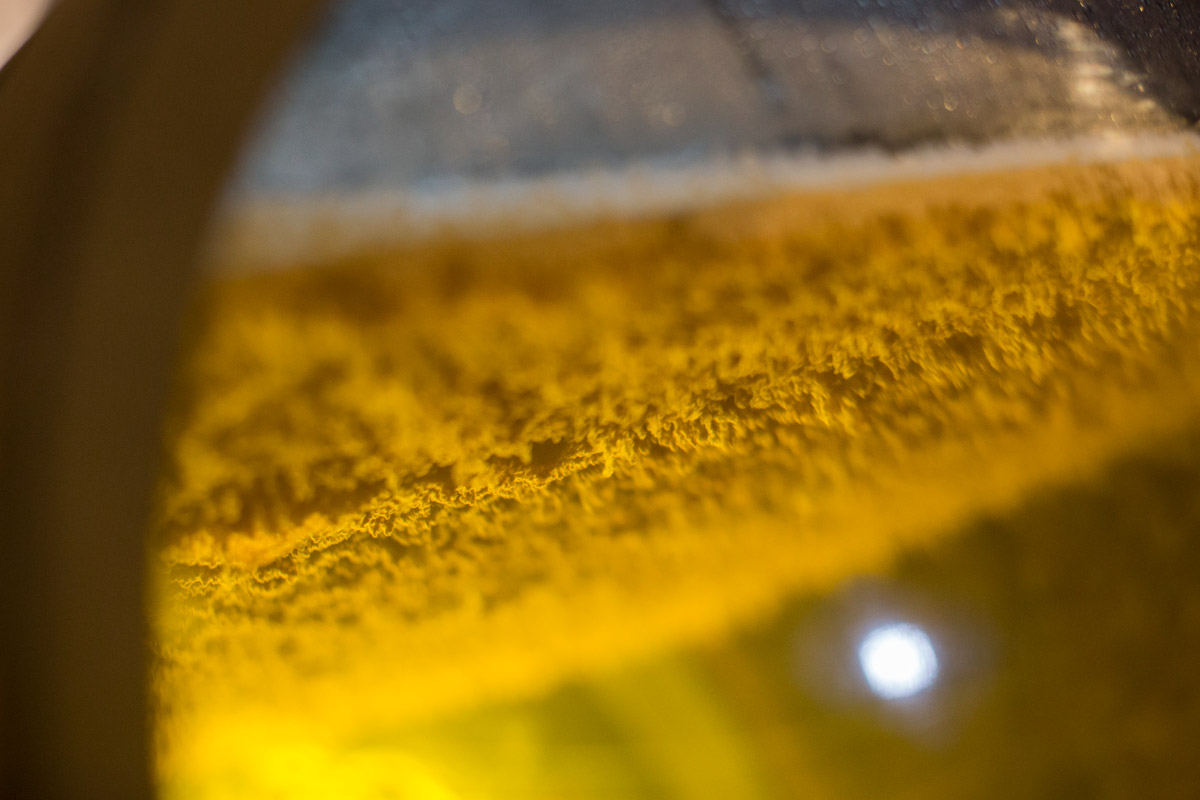Fermentation is one of the oldest and most intriguing transformations in the culinary world. Across cultures and centuries, this natural process has not only preserved food but also enhanced its flavors, textures, and complexity. Whether it’s the tang of kimchi, the rich umami of miso, or the layered depth of a well-aged cheese, fermentation is the secret ingredient behind many of the world’s most beloved foods.
Jerez wines, where unique aging processes further develop flavors ranging from crisp and briny to deep and nutty. Pairing fermented foods with sherry wines unlocks an extraordinary symphony of flavors, bringing out layers of complexity that elevate both the food and the wine.
fermentation and flavor, we’ll dive into the different types of food fermentation processes, how they impact taste, and why Lustau sherry wines are the perfect partners for these intriguing flavors.
INTRODUCTION TO FERMENTED FOODS
Fermentation is the process by which microorganisms such as bacteria, yeast, or fungi break down sugars into alcohol, acid, or gas. While it started as a method of preserving food, fermentation has become prized for its ability to enhance flavors, introduce complexity, and transform ordinary ingredients into something exceptional.
Moreover, fermented foods provide numerous health benefits, particularly for gut health and digestion. Rich in probiotics, they introduce beneficial bacteria that support nutrient absorption, immune function, and overall well-being. Fermentation also pre-digests nutrients, making vitamins and minerals bioavailable and reducing antinutrients. Additionally, these foods contain enzymes and organic acids that aid digestion, reduce bloating, and promote gut motility. Incorporating foods like yogurt, kimchi, miso, and aged cheeses enhances both flavor and digestive balance, reinforcing the deep connection between traditional food practices and health.

From the sharp bite of sauerkraut to the tangy depth of sourdough bread, fermentation adds layers of acidity, umami, and richness that make foods more dynamic. It also plays a crucial role in wine, beer, vinegar, and spirits, demonstrating how this process bridges the worlds of gastronomy and beverages.
WHAT IS FERMENTATION AND WHY DOES IT ENHANCE FLAVORS?
At its core, fermentation is a biochemical reaction that alters food’s structure, unlocking new aromas, textures, and depth. The fermentation process:
• Develops acidity, which brightens flavors and enhances balance.
• Creates umami, adding savory richness and depth.
• Softens textures, making food more palatable and digestible.
• Boosts aromatics, introducing nutty, fruity, or yeasty notes.
For these reasons, fermented food and wine pairings are some of the most versatile and exciting in gastronomy.
MAIN TYPES OF FERMENTATION IN FOODS AND BEVERAGES
Fermentation occurs in many forms, each producing distinct flavors and characteristics. The four primary types of food fermentation are:
Lactic Fermentation (e.g., yogurt, kimchi, sauerkraut)
This process converts sugars into lactic acid, resulting in foods that are tangy, refreshing, and slightly sour. Lactic fermentation is the foundation of foods like kimchi, pickles, kefir, and sourdough bread.
Alcoholic Fermentation (e.g., beer, wine, sake)
Driven by yeasts, this process transforms sugars into alcohol and carbon dioxide, giving rise to wines, beers, ciders, and spirits. In Jerez wines, this fermentation process is just the beginning, as subsequent aging under “flor” or oxidation creates the signature styles of sherry.

Acetic Fermentation (e.g., vinegar, kombucha)
When ethanol is exposed to oxygen, bacteria transform it into acetic acid, creating tangy, sharp, and aromatic products like vinegar, kombucha, and balsamic reductions.
Mixed Fermentation (e.g., miso, soy sauce, tempeh)
Some ingredients undergo multiple fermentation processes, leading to deep umami complexity. Foods like miso, soy sauce, and tempeh are created through a combination of yeasts, molds, and bacteria, resulting in rich, earthy, and highly savory flavors.
HOW FERMENTATION TRANSFORMS FLAVORS AND TEXTURES
Fermentation is a natural transformation of sugars, proteins, and other compounds that enhances flavor, texture, and complexity in both food and beverages. It introduces acidity, umami, and aromatic depth, making ingredients more vibrant and layered.
In foods, fermentation sharpens flavors, softens textures, and boosts umami, as seen in kimchi, miso, and aged cheeses. In beverages like wine, yeasts convert sugars into alcohol and aromatic compounds, creating structure and character. This process lays the foundation for further evolution—whether through barrel aging in wine or maturation in cheeses and soy-based condiments.
THE BRIDGE BETWEEN FERMENTATION AND AGING
Once primary fermentation is complete, food and wines may continue to develop through aging. This shared journey highlights why aged wines and aged foods naturally complement each other, creating balanced and expressive pairings. In Jerez wines, this aging follows two distinct paths:
• Biological Aging (Fino & Manzanilla) – A layer of flor yeast consumes oxygen and glycerol (among others), creating a bone-dry, saline profile that mirrors, for instance, the crispness of pickled or lactic-fermented foods (such as olives).
• Oxidative Aging (Oloroso, Palo Cortado, PX) – Slow exposure to oxygen deepens color, enriches texture, and enhances nutty, umami flavors, much like the extended fermentation of aged cheeses or miso.
FERMENTATION AND PAIRING SYNERGY
Because fermentation intensifies flavor and refines texture, it creates natural pairing affinities between Jerez wines and fermented foods. The saline bite of manzanilla heightens the brightness of pickled vegetables, while the nutty warmth of amontillado complements the richness of miso or soy-based sauces. This shared transformation results in a harmonious interplay of acidity, umami, and depth, making these pairings exceptionally nuanced.
PAIRING FERMENTED FOODS WITH LUSTAU SHERRY WINES
The layered complexity of fermented foods demands a wine that can match its intensity, acidity, and umami character. Sherry wines, with their wide range of styles, are uniquely suited for these pairings. From the saline crispness of fino to the rich depth of oloroso, each style brings out something different in fermented food and wine pairings.
SHERRY WINE STYLES AND THEIR BEST FERMENTED FOOD PAIRINGS
A well-maintained cask allows for a controlled aging process, where oxidation and wood interaction occur harmoniously. Poorly maintained barrels, however, can lead to spoilage or inconsistencies in flavor. The knowledge and skills of sherry coopers ensure that each cask contributes positively to the aging process, resulting in a refined and balanced sherry.
Get to know the sherry effect and how every sherry affects to the barrel wood
THE ROLE OF CASKS IN SHERRY’S UNIQUE FLAVORS
Biological Aging: Fino & Manzanilla – Crisp, saline, and refreshing
• Perfect with: Marinated olives, pickled vegetables, fresh goat cheese.
• Why? The briny, yeasty notes of fino and manzanilla enhance the saline bite of pickled foods while refreshing the palate.
Mixed Aging: Amontillado – Nutty, structured, and complex
• Perfect with: Miso soup, aged cheeses, soy sauce-glazed dishes.
• Why? The toasted almond and caramel notes of amontillado blend beautifully with the savory, umami depth of aged and fermented foods.
Oxidative Aging: Palo Cortado & Oloroso – Deep, rich, and umami-driven
• Perfect with: Dry-aged meats, tempeh, fermented black garlic.
• Why? The rich, nutty intensity of palo cortado and oloroso complements the depth of aged and umami-packed ingredients.
Oxidative Aging: Cream – Velvety texture with balanced sweetnes
• Perfect with: Blue cheese, balsamic vinegar, tamari-glazed nuts.
• Why? The gentle sweetness and smooth mouthfeel of cream sherry create a balanced contrast with salty, tangy flavors.
Oxidative Aging: >Moscatel & Pedro Ximénez – Intensely sweet and luscious
• Perfect with: Dark chocolate, aged balsamic, sweet miso glazes.
• Why? The raisiny, fig-like richness of moscatel and PX amplifies the deep caramelized notes of aged and fermented sweets.
THE PERFECT FUSION OF FERMENTED COMPLEXITY AND SHERRY ELEGANCE
Fermentation is the art of transforming simple ingredients into flavor-packed, umami-rich delicacies. In the same way, Jerez wines evolve over time, developing aromas, textures, and depth that make them the perfect match for fermented foods.
Whether it’s the briny crispness of fino with olives, the deep umami of oloroso with aged meats (enzymatic breakdown process), or the luxurious sweetness of PX with dark chocolate, fermentation and sherry share a timeless connection—one that invites endless exploration.
Next time you reach for a bottle of Lustau sherry, consider pairing it with your favorite fermented dish. The results may just redefine the way you experience food and wine pairings.







